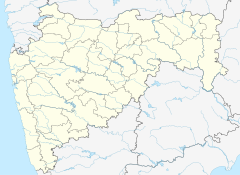
Vīrabhadra, also known as Veerabadhra, Veerabathira, Veerabathiran is an extremely fierce and fearsome form of the Hindu god Shiva. He was created by the wrath of Shiva and destroyed the Yagna of Daksha, after Daksha's daughter and Shiva's consort Sati self-immolated in the sacrificial fire. He is described as a warrior who eventually blinded Bhaga, subdued Indra and broke, among many other countless gods, Pushan's teeth. Other gods fled the battlefield unable to sustain his power.
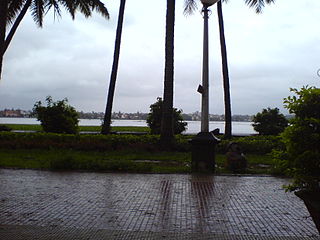
Rankala Lake is a picturesque lake in the Kolhapur District of the state of Maharashtra in western India.

Mahalakshmi Temple, is an important Hindu temple dedicated to Goddess Mahalakshmi, located in the heart of ancient city of Kolhapur, Maharashtra, India. It is one of 51 shaktipeeths according to Devi Purana, one of 18 Mahashaktipeeths as per Sankar Samhita of Skanda Purana and Ashta Dasa Shakti Peetha Stotram, and one of 3½ Shaktipeeths located in Maharashtra.

The Shakti Pitha are significant shrines and pilgrimage destinations in Shaktism, the goddess-focused Hindu tradition. There are 51 Shakti peethas by various accounts, of which 18 are named as Maha (major) in medieval Hindu texts.

The Kanchi Kailasanathar temple is the oldest structure in Kanchipuram. Located in Tamil Nadu, India, it is a Hindu temple in the Tamil architectural style. It is dedicated to the Lord Shiva, and is known for its historical importance. The temple was built from 685-705 AD by a Rajasimha ruler of the Pallava Dynasty. The low-slung sandstone compound contains a large number of carvings, including many half-animal deities which were popular during the early Pallava architectural period. The structure contains 58 small shrines which are dedicated to various forms of Shiva. These are built into niches on the inner face of the high compound wall of the circumambulatory passage. The temple is one of the most prominent tourist attractions of the city.

The Shilahara Dynasty was a royal clan that established itself in northern and southern Konkan, present-day Mumbai and southern Maharashtra (Kolhapur) during the Rashtrakuta period.

Saptashrungi or Saptashringi is a site of Hindu pilgrimage, situated 60 kilometres (37 mi) from Nashik in the Indian state of Maharashtra. According to Hindu traditions, the goddess Saptashrungi Nivasini dwells within the seven mountain peaks. It is located in Nanduri, Kalwan taluka, a small village near Nashik in India. The Marathas and some Bhil tribes have been worshipping the goddess for a long time and some worship her as their Kuldaivat. There are 510 steps to climb the gad. Devotees visit this place in large numbers every day. The temple is also known popularly as one of the "three and a half Shakti Peethas" of Maharashtra. The temple is also one among the 51 Shakti Peethas located on the Indian subcontinent and is a location where one of Sati's limbs, her right arm is reported to have fallen. It is half shaktipeeth among three and a half shaktipeeth of Maharashtra.

Shiva Puja is the name of the action in Hinduism by which one worships Lord Siva through traditional and ancient rites with the use of mantra, tantra, yantra, kriyas, mudras, and abhishekam.

Brihadishvara temple, also called Rajarajeswaram or Peruvudaiyār Kōvil, is a Hindu temple dedicated to Shiva located in South bank of Kaveri river in Thanjavur, Tamil Nadu, India. It is one of the largest South Indian temples and an exemplary example of a fully realized Tamil architecture. It is called as Dhakshina Meru. Built by Tamil king Raja Raja Chola I between 1003 and 1010 AD, the temple is a part of the UNESCO World Heritage Site known as the "Great Living Chola Temples", along with the Chola dynasty era Gangaikonda Cholapuram temple and Airavatesvara temple that are about 70 kilometres (43 mi) and 40 kilometres (25 mi) to its northeast respectively.
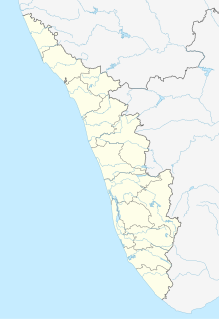
Kankol is a village in Kerala, Kannur district India. Kankol village is a part of Kankol Alapadamba Grama Panchayath, which had won the Swaraj Trophy (1999–2000) for the best grama panchayath in Kerala state. Post office and village office representing Kankol are situated in the place named Kundayamkovval.
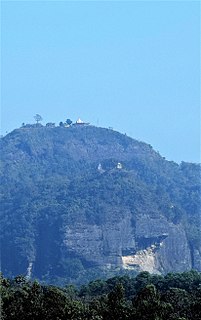
Chandranath Temple, located on top of the Chandranath Hill, is a famous Shakti Peeth located near Sitakunda in Bangladesh where, as per Hindu sacred texts, the right arm of Goddess Sati fell. Chandranath Temple is a pilgrimage site for Hindus. Its height about 1,020 feet (310 m) above sea level.
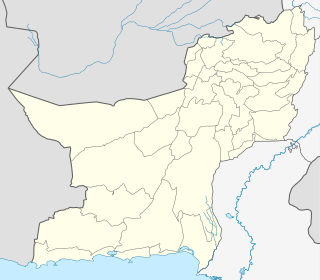
Shivaharkaray or Karavipur is a Shakti Peeth dedicated to the Hindu Goddess Durga, located near Parkai railway station, near Karachi, Pakistan. It is one of the two Shakti Peethas in Pakistan, other being Hinglaj Mata mandir Puranas describe that the three eyes of the Goddess fell here after she committed Sati. The Goddess is worshipped as Mahishasuramardini, or the slayer of the Demon Mahishasur. Her consort, the Hindu God Shiva, is worshipped in Ragi form as Krodhish, personification of anger. Shivaharkaray is third in the list of 51 Peethas identified in the Puranas.

Mahadeva Temple, Tambdi Surla is a 12th-century Shaivite temple in the Kadamba style dedicated to Lord Shiva and an active place of Hindu worship. It is an ASI protected Monument of National Importance in Goa.
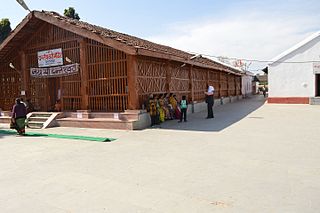
Danteshwari Temple is temple dedicated to Goddess Danteshwari, and is one of the 52 Shakti Peethas, shrines of Shakti, the divine feminine, spread across India. The temple built in the 14th century, is situated in Dantewada, a town situated 80 km from Jagdalpur Tehsil, Chhattisgarh. Dantewada is named after the Goddess Danteshwari, the presiding deity of the earlier Kakatiya rulers. Traditionally she is the Kuldevi of Bastar state,
Shri Shail is one of the Shakti Peeths, at Joinpur village, Dakshin Surma, near Gotatikar, 3 km south-east of Sylhet town, Bangladesh. The Hindu Goddess Sati's neck fell here. The Goddess is worshipped as Mahalakshmi and the Bhairav form is Sambaranand.
Sugandha Shaktipeeth, a temple of the Goddess Sunanda, is located in the village of Shikarpur, 10 miles north of Barisal, in Bangladesh. This Hindu temple is one of the Shakti Peethas.

Shailaputri (शैलपुत्री, lit. daughter of the mountain is a manifestation of the Hindu Mother Goddess, Durga and is the first Navadurga venerated during the first day of Navratri. She was the daughter of the mountain King Himavan, and his wife, Mainika. Her birth name is Kali, because she had a dusky/dark complexion.
In Hindu mythology, Daksha-Yajna(m) or Daksha-Yaga is an important event, which is narrated in various Hindu scriptures. It refers to a yajna (sacrifice) organized by Daksha, where his daughter Sati immolated herself. The wrath of god Shiva, Sati's husband, thereafter destroyed the sacrifice. The tale is also called Daksha-Yajna-Nasha. The story forms the basis of the establishment of the Shakti Peethas, temples of the Hindu Divine Mother. It is also becomes a prelude to the story of Parvati, Sati's reincarnation who later marries Shiva.
Kodlamane is a Tirth Khestra and Hindu pilgrimage site where Kodlamane Shree Vishnumurthy Temple is located. It is located in a hill forest. As per local legend the temple was discovered in the middle of dense forest centuries back. It is in Honnavar Taluka of Uttara Kannada district in Karnataka state. A natural stream flows next to the Shree Vishnumurthy Temple, which is called Vishnu Tirth.

Nandikeshwari Temple, also known as Nandikeshwari Tala, is located in Sainthia city of West Bengal. This temple is part of the famous Shakti Peethas in Indian Subcontinent.

